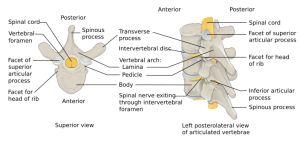Odontoid fracture
Revision as of 04:17, 2 January 2015 by Rossdonaldson1 (talk | contribs) (Created page with "==Background== *Also known as dens fracture *Only stable if fx confined to avulsion of the tip (superior to transverse ligament) ==Clinical Features== *Frequently involves ot...")
Background
- Also known as dens fracture
- Only stable if fx confined to avulsion of the tip (superior to transverse ligament)
Clinical Features
- Frequently involves other cervical spine injuries
- 25% assoc w/ neurologic injury
Differential Diagnosis
Vertebral fractures and dislocations types
- Cervical fractures and dislocations
- Thoracic and lumbar fractures and dislocations
Workup
- Types
- Type I: Oblique avulsion fx of tip of odontoid; alar ligament avulsion
- Stable
- atlanto-occipital instability should be ruled out with flexion and extension films
- Type II: Fx at base of odontoid process where it attaches to C2; Fx through waist
- Unstable
- high nonunion rate due to interruption of blood supply
- Young: Halo if no risk factors for nonunion, Surgery if risk factors for nonunion
- Elderly: Collar if not surgical candidates, Surgery if surgical candidates
- Type III: Extension of the fx through upper portion of body of C2
- Unstable
- Type I: Oblique avulsion fx of tip of odontoid; alar ligament avulsion
- Imaging
- Xray: AP, lateral, open-mouth odontoid view of cervical spine
- CT for further assessment if fracture identified
Management
- Prehospital Immobilization see NAEMSP National Guidelines for Spinal Immobilization
- consult ortho/nsg/trauma




